PYRO-Eco Stove for Cooking on Rural Areas
(Economical and Environmentally Friendly)
I am not a member of Environmental Management Group, but I do help on clean and green, especially our surroundings.
We should implement environmental awareness without delay. It is the way to keep ourselves healthy. As you can see in my previous articles, I plant trees and vegetables, and use kitchen wastes for fertilizer.
I have a friend, who is a member of EMG (Environmental Management Group). He asked me to produce a prototype economical and ecological stove for use on rural areas, especially designed for developing countries.
Pollution is terrible all over the world, and we know it. As I stay in rural area most of the time (just to escape from polluted cities), I use dried falling leaves, dried tree branches, and waste papers for cooking. The downside is that it produces too much smoke when burned. To help reduce smoke and carbon dioxide, I tried to make a special stove out of waste tin cans.
I have seen a lot of wood-fueled stoves in Asian countries. One of them was as unique as seen in below illustration.
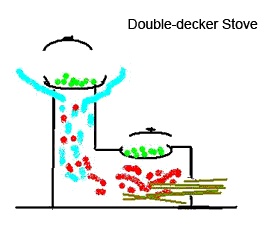
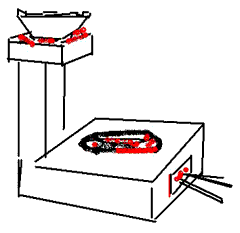
This unique "double-decker stove" is what I saw in Cambodia and its neighboring countries. Yes, it cooks at the lower main side and at the chimney at the same time. It seems to be a wise idea, but actually this system consumes more firewood.
There are others made of clay or junk metal. However, most of them are not made for environmental and economical reasons. They are just made for ease-of-use purposes.
These stoves are known in Japan up to this modern time since 60 to 70 years ago. I myself had used them for nearly 40 years. |
These stoves are used in most Southeast Asian countries and Latin American countries as well as in the African continent. |
These stoves are cheap. They cost only about US$10, but they are not environmentally friendly.
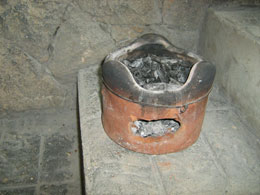
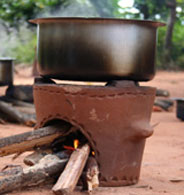
Our main point for cooking should be economical and produce less pollution. Stove should be small and light. The stove should be made of low-cost materials from junk materials, clay, and cement, which are widely available in rural areas of developing countries.
Fuel materials such as waste wood, charcoal, and dry leaves to waste papers can be used.
I remember a stove my father, a machinist, made 50 years ago in his factory. It had been used for quite some time, so, I duplicated it in my memory. It is made of used tin cans and is riveted as seen in below photos.
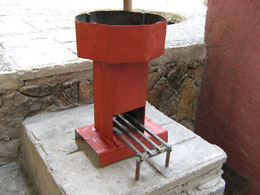
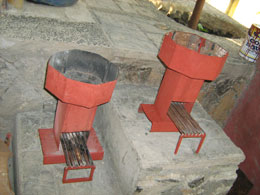
According to my environmentalist friend, it looks like a "Rocket Stove" as they call it. Whatever it is, its efficiency is amazing.
This photo shows 1 kilogram of cardboard box. Only one half of it or 100 pieces of newspaper is enough to cook six cups of rice and two kinds of dishes out of 500 grams of waste cardboards. |
These photos show cooking Chinese-style Ramen using bits of cardboard. |
Yes, it produces less smoke, less carbon dioxide, and more efficient transfer of heat into the cooking vessel, which in turn means nearly 60% less fuel consumption. Furthermore, the design of the stove requires small diameter lengths of wood that small branches will do. By itself, enough fuel for cooking can be gathered in less time, without needing tools, and ideally you'll contribute in saving our forested areas. Isn't it a very big savings in cost of firewood? It greatly reduces indoor air pollution, too.
I have produced several of these stoves and distributed it to the Environmental Management Group. I am now in schedule to produce it for poor families in developing countries.
My wife and I enjoy cooking using the prototype environmentally friendly stove I made. It costs about US$5 only. Why don't you make one? According to the United Nations Environment Management Group, the number of wood-burning cooking stove users is tremendously increasing, especially in the US. |
Mr. Takano, the author |
Stove Specifications
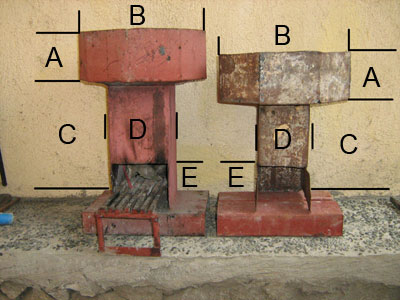
A……depth of pot skirt is 3 inches high (8 cm)
B……width or diameter of pot skirt is 10 inches (25 cm)
C……height of combustion chimney is 10 inches (25 cm)
D……width of combustion chimney is 4 inches (10 cm)
E……opening for firewood and air intake is 4 inches (10 cm)The small stove (unpainted) is:
A……depth of pot skirt is 3 inches high (8 cm). You need the same size as the big stove to settle a standard pot.
B……width or diameter of pot skirt is 10 inches (25 cm)
C……height of combustion chimney is 8 inches (20 cm)
D……width of combustion chimney is 3 inches (8 cm)
E……opening for firewood and air intake is 3 inches (8 cm)
Opening for firewood and air intake is divided with bar grills.
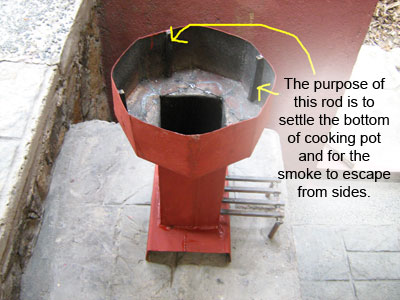
What is the difference between the two? If you want to cook under big fire, then make the big one. If you are not in a hurry to cook with big flames, then the small stove is good enough. Firewood or newspaper consumption is nearly the same.
We recommend you to use cast iron cookware or clay cookware. See the article "Using Cast Iron Cookware Helps Blood (Anemia) and Iron Deficiency".
What is the main reason of using clay cookware? In rural areas of third world countries, clay cookware is cheap and available in various sizes, shapes, and usage. Nutrients remain and preserved better when foods are cooked in clay, compared to stainless or aluminum cookware. Foods in clay are cooked slowly and will remain hot for longer duration especially in cold countries or in winter. Foods cooked in clay are also tastier than using metal cookware. It is because the food nutrients are maintained in better condition.
Many claim that people who cook food with firewood with clay cookware remain healthier than people who live with modern kitchen facilities, although there is no scientific evidence to support this. But if all people use Eco Stove, more than 50% firewood and 50% carbon dioxide produced by conventional stove will be saved. And for sure, more people will live healthier than today.
Stove Made of Cement and Clay
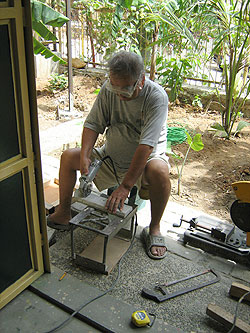
Mr. Takano works to cut pieces of cement blocks for constructing the new PYRO-Eco Stove for demo and trial at his workshop.
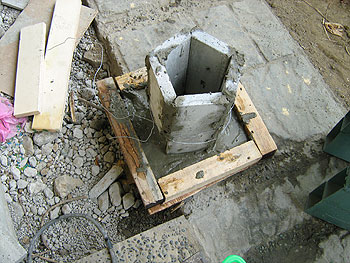
Cement blocks are joined to build the combustion section of the stove.
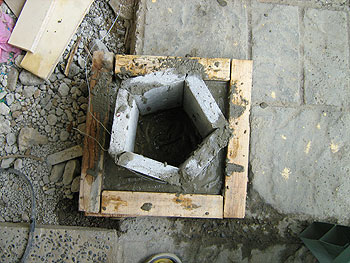
Cement blocks joined with cement at the bottom. From top view.
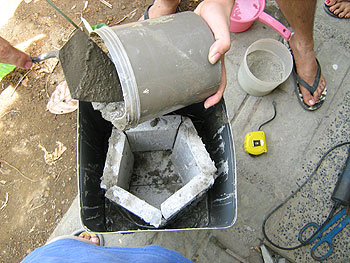
Insert the cement blocks in a cookie tin.
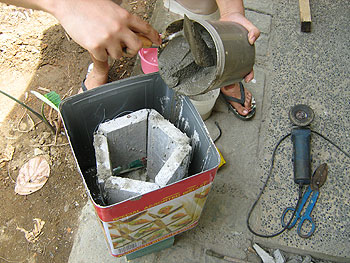
Pour the cement at the top of the combustion chamber.
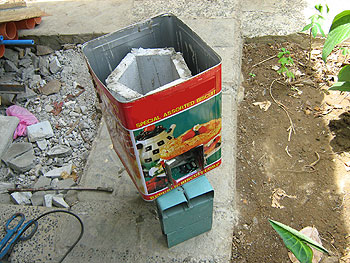
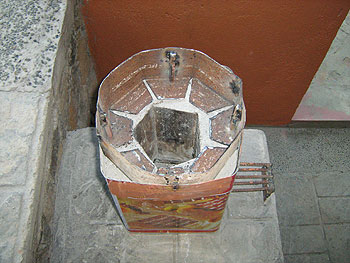
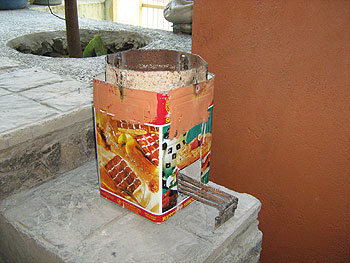
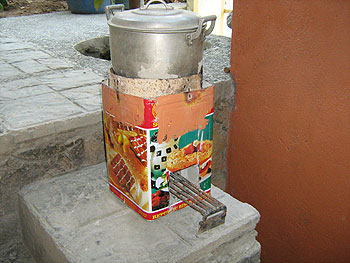
PYRO-ENERGEN Trivia
Why are there fewer diseases behind firewood-cooking users? It is because the negative energy does not exist around the firewood flame. PYRO means fire. Do you remember it?
PYRO-ENERGEN technology is ahead of conventional theories they knew.
Reprint Rights: You may reprint this article within your website, blog, or newsletter as long as the entire article remains the same as well as the “About the Author” box.



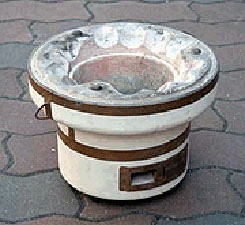
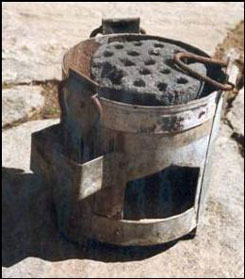
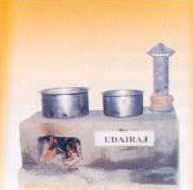

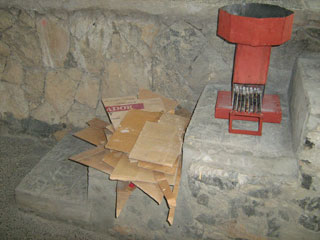

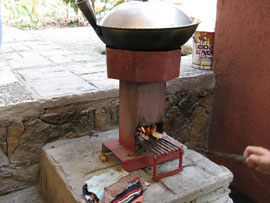
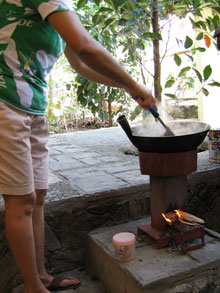
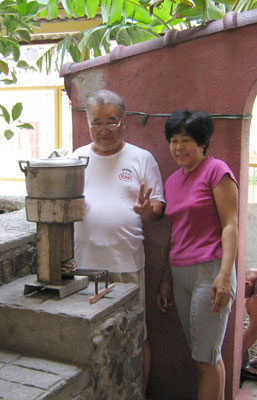
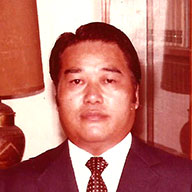 Junji Takano is a Japanese health researcher involved in investigating the cause of many dreadful diseases. In 1968, he invented PYRO-ENERGEN, the first and only electrostatic therapy machine that effectively eradicates viral diseases, cancer, and diseases of unknown cause.
Junji Takano is a Japanese health researcher involved in investigating the cause of many dreadful diseases. In 1968, he invented PYRO-ENERGEN, the first and only electrostatic therapy machine that effectively eradicates viral diseases, cancer, and diseases of unknown cause.


